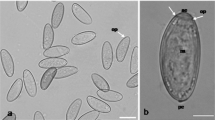Abstract
Light microscopy (LM) and scanning electron microscopy (SEM) were used to determine interspecific differences between various larval stages of 2 allopatric species of 37-collar-spined echinostomes,Echinostoma caproni andE. trivolvis. The abopercular and embryo diameters of the eggs ofE. trivolvis were significantly different from those ofE. caproni. The abopercular knobs ofE. caproni andE. trivolvis have shallow and deep infoldings in the eggshells, respectively. Interspecific differences were noted in the tegument, tegumentary papillae, and spherical bodies around the mouth and in the papilliform process of the two rediae. The cercaria ofE. caproni has one ventral tail fin-fold, whereas that ofE. trivolvis has two; both species have two dorsal tail fin-folds. The outer metacercarial cyst diameter ofE. caproni was significantly greater than that ofE. trivolvis. E. caproni has a smoother outer cyst wall than doesE. trivolvis.
Similar content being viewed by others
References
Beaver PC (1937) Experimental studies onEchinostoma revolutum (Froelich), a fluke from birds and mammals. Ill Biol Monogr 15:1–96
Donovick RA, Fried B (1988) Scanning electron microscopy ofEchinostoma revolutum andE. liei from domestic chicks. J Pa Acad Sci 62:78–82
Fried B, Awatramani R (1992) Light and scanning electron microscopical observations of the daughter rediae ofEchinostoma trivolvis (Trematoda). Parasitol Res 78:257–259
Fried B, Emili S (1988) Excystation in vitro ofEchinostoma liei andE. revolutum (Trematoda) metacercariae. J Parasitol 74:98–102
Fried B, Fujino T (1987) Argentophilic and scanning electron microscopic observations of the tegumentary papillae ofEchinostoma revolutum (Trematoda) cercariae. J Parasitol 73:1169–1174
Fried B, Schafer S, Kim S (1989) Effects ofEchinostoma caproni infection on the lipid composition ofBiomphalaria glabrata. Int J Parasitol 19:353–354
Fried B, Irwin SWB, Lowry SF (1990) Scanning electron microscopy ofEchinostoma trivolvis andE. caproni (Trematoda) adults from experimental infections in the golden hamster. J Nat Hist 24:433–440
Fujino T, Fried B (1993) Expulsion ofEchinostoma trivolvis (Cort, 1914) Kanev, 1985 and retention ofE. caproni Richard, 1964 (Trematoda: Echinostomatidae) in C3H mice: pathological, ultrastructural, and cytochemical effects on the host intestine. Parasitol Res 79:286–292
Huffman JE, Fried B (1990)Echinostoma and echinostomiasis. Adv Parasitol 29:215–269
Irwin SWB, Fried B (1990) Scanning and transmission electron microscopic observations on metacercariae ofEchinostoma trivolvis andE. caproni during in vitro excystation. J Helminthol Soc Wash 57:79–83
Irwin SWB, Threadgold LT, Howard NM (1978)Cryptocotyle lingua (Creplin) (Digenea: Heterophyidae): observations on the morphology of the redia, with special reference to the birth papilla and release of cercariae. Parasitology 76:193–199
Ishii Y (1991) Electron micrographs of parasitic helminths. Maruzen, Fukuoka, Japan, pp 3–82
Jeyarasasingam U, Heyneman D, Lim H-K, Mansour N (1972) Life cycle of a new echinostome from Egypt,Echinostoma liei sp. nov. (Trematoda; Echinostomatidae). Parasitology 65:203–222
Kanev I, Fried B (1982) Further studies of cercariaEchinostoma revolutum Beaver, 1937 (Trematoda: Echinostomatidae). Khelmintologia 14:44–52
Køie M (1971) On the histochemistry and ultrastructure of the redia ofneophalis langenformis (Lebour, 1910) (Trematoda: Acanthacoepidae). Ophelia 9:113–143
Rees G (1980) Surface ultrastructure of the redia ofParorchis acanthus, Nicoll (Digenea: Philophthalmidae). Z Parasitenkd 63:33–46
Valkounova J, Zdarska Z, Nasincova V (1989) Ultrastructural observations on the redia ofEchinostoma revolutum (Froelich, 1802). Folia Parasitol 36:25–30
Author information
Authors and Affiliations
Rights and permissions
About this article
Cite this article
Krejci, K.G., Fried, B. Light and scanning electron microscopic observations of the eggs, daughter rediae, cercariae, and encysted metacercariae ofEchinostoma trivolvis andE. caproni . Parasitol Res 80, 42–47 (1994). https://doi.org/10.1007/BF00932622
Received:
Accepted:
Issue Date:
DOI: https://doi.org/10.1007/BF00932622




